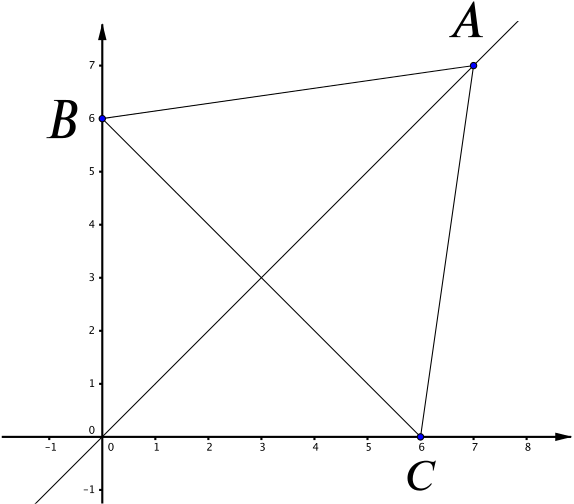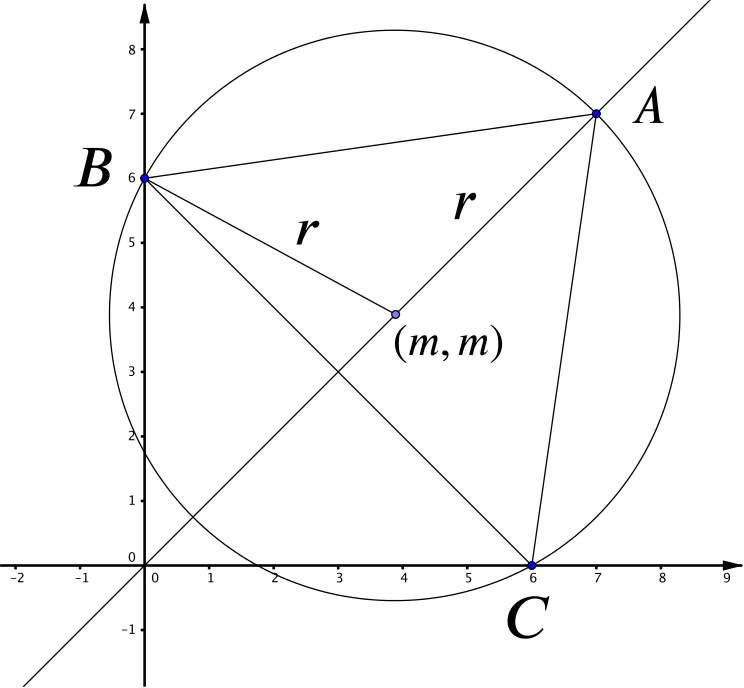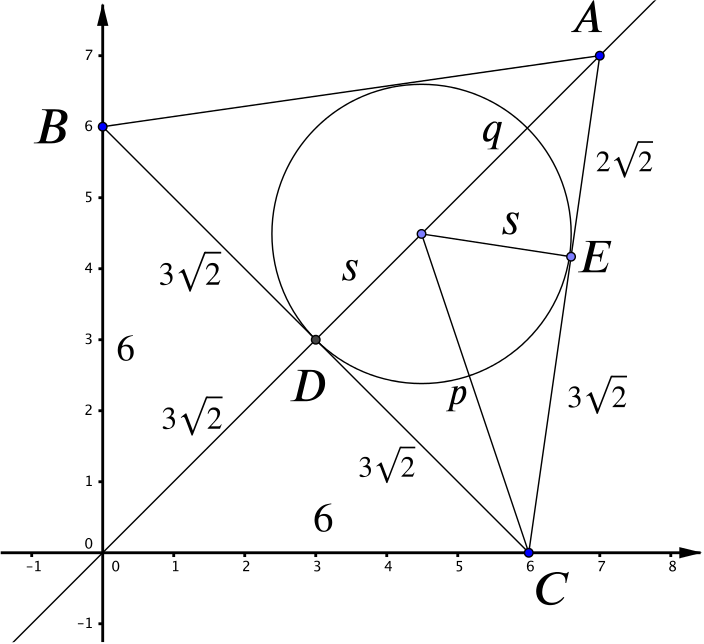The triangle \(ABC\) has vertices \(A(7, 7), B (0, 6)\) and \(C (6, 0)\). Write down the equation of the internal bisector of the angle \(BAC\).

By symmetry, we can see that the equation of the line is \(y = x\).
Find, by an algebraic method,
- the equation of the circle through the points \(A, B\) and \(C\)…

We are asked for the equation of the circumcircle (the circle that passes through each of the triangle’s vertices) of the triangle, which always exists.
Again by the symmetry of the triangle, the circumcentre (the centre of the circumcircle) must lie on \(y = x\), let’s say at \((m, m)\).
The circumcentre must be the same distance from \(A\) as from \(B\), so
\[(7-m)^2+(7-m)^2 = (6-m)^2 + (0-m)^2 \implies -28m +98= 36 -12m \implies m = \dfrac{31}{8}.\]
So the equation we seek is \(\left(x-\dfrac{31}{8}\right)^2+\left(y-\dfrac{31}{8}\right)^2 = r^2.\)
Putting \((0,6)\) into this equation gives \(r^2 = \dfrac{625}{32}\), and so finally we have our equation;
\[\left(x-\dfrac{31}{8}\right)^2+\left(y-\dfrac{31}{8}\right)^2 = \dfrac{625}{32}.\]
The question doesn’t specify the form in which to leave the equation, so we can leave it with brackets.
If we wish to remove the fractions, we reach \((8x-31)^2+(8y-31)^2=1250\).
- the equation of the inscribed circle of the triangle \(ABC\), i.e. the circle which touches all three sides of this triangle and which has its centre within the triangle.

Again by the symmetry of the triangle, the centre of the inscribed circle must lie on \(y = x\), let’s say at \((n, n)\).
It’s easy to calculate the various lengths on the diagram. We know \(D\) is \((3, 3)\), and so \(OD = DC= CE\) is \(3\sqrt{2}\) (by symmetry). But we know \(AC\) is \(5\sqrt{2}\), and so \(CA\) is \(2\sqrt{2}\).
We have from the diagram that \(p^2 = (3\sqrt{2})^2 + s^2\), while \(q^2 = (2\sqrt{2})^2 +s^2\).
Subtracting these equations gives us that \(10 = p^2-q^2 = (n-6)^2+(n-0)^2-(7-n)^2-(7-n)^2\).
Multiplying out and solving for \(n\) here gives us that \(n = \dfrac{9}{2}\).
So the equation of the inscribed circle is \(\left(x-\dfrac{9}{2}\right)^2+\left(y-\dfrac{9}{2}\right)^2 = s^2\).
We can see from the diagram that \(q + s = AD = 4\sqrt{2}\), and thus \(s = 4\sqrt{2} - \sqrt{\dfrac{25}{2}} = \dfrac{3}{2}\sqrt{2}\).
So finally, the inscribed circle has equation \(\left(x-\dfrac{9}{2}\right)^2+\left(y-\dfrac{9}{2}\right)^2 = \dfrac{9}{2}\).

